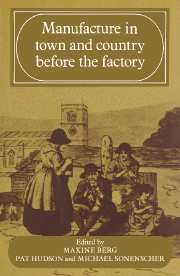Book contents
- Frontmatter
- Contents
- List of illustrations
- Acknowledgements
- 1 Manufacture in town and country before the factory
- 2 Political economy and the principles of manufacture 1700–1800
- PART I THE STRUCTURE OF MANUFACTURE
- 3 Variations in industrial structure in pre-industrial Languedoc
- 4 Seasonal fluctuations and social division of labour: rural linen production in the Osnabrück and Bielefeld regions and the urban woollen industry in the Niederlausitz, c. 1770–c. 1850
- 5 From manor to mill: the West Riding in transition
- PART II ‘WORK’ AND ‘WAGES’
- Appendix 1 Norwich embezzlement convictions in the eighteenth century: problems of evidence
- Appendix 2 Estimates of the size of the supplement to wages available through embezzlement in two eighteenth-century industries
- Appendix 3 Statutes concerned with embezzlement in the putting-out industries, 1500–1800
- Index
4 - Seasonal fluctuations and social division of labour: rural linen production in the Osnabrück and Bielefeld regions and the urban woollen industry in the Niederlausitz, c. 1770–c. 1850
Published online by Cambridge University Press: 16 October 2009
- Frontmatter
- Contents
- List of illustrations
- Acknowledgements
- 1 Manufacture in town and country before the factory
- 2 Political economy and the principles of manufacture 1700–1800
- PART I THE STRUCTURE OF MANUFACTURE
- 3 Variations in industrial structure in pre-industrial Languedoc
- 4 Seasonal fluctuations and social division of labour: rural linen production in the Osnabrück and Bielefeld regions and the urban woollen industry in the Niederlausitz, c. 1770–c. 1850
- 5 From manor to mill: the West Riding in transition
- PART II ‘WORK’ AND ‘WAGES’
- Appendix 1 Norwich embezzlement convictions in the eighteenth century: problems of evidence
- Appendix 2 Estimates of the size of the supplement to wages available through embezzlement in two eighteenth-century industries
- Appendix 3 Statutes concerned with embezzlement in the putting-out industries, 1500–1800
- Index
Summary
Seasonal fluctuations have been assumed to be one of the main characteristics of pre-industrial production processes. The rhythms of climate and the seasons regulated the economic cycle of societies dominated by agriculture. Natural rhythms rather than time discipline determined the flow of work. And the chronic imbalance of labour supply between the peak and slack times of the year are said to have limited production possibilities. Modern industry has been associated with regularity, continuity and, ultimately, the elimination of fluctuation in output caused by man or nature. A recent version of this characteristic division between traditional and modern societies has been set out by Franklin Mendels: ‘We can thus consider primitive agriculture and the assembly line as the end points of a linear evolution marked by a progressively increasing continuity and intensity of work over the centuries, an approach that makes it easier to place “proto-industrialisation” in its proper perspective.’
This essay demonstrates the extent to which this dichotomy and the notion of linear evolution are far too simple. Different regions manifested different production cycles and seasonal fluctuations which do not necessarily accord with what we think about their relative ‘progress’ or backwardness. Another characteristic separating modern from traditional production processes is supposed to have been the degree of social division of labour. But in the cases studied in this paper we notice that as late as around 1800 a very low degree of social division of labour in a region could be regarded as an economic advantage; and only from the point of view of capitalist industrialisation did it seem self-evident that ‘modernisation’ meant a growing division of labour.
- Type
- Chapter
- Information
- Manufacture in Town and Country Before the Factory , pp. 92 - 123Publisher: Cambridge University PressPrint publication year: 1983
- 4
- Cited by



